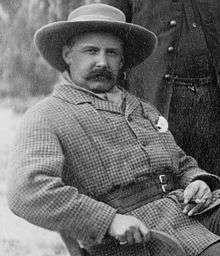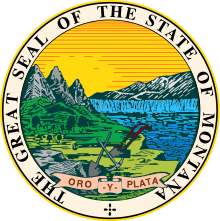John Schuyler Crosby
| John Schuyler Crosby | |
|---|---|
 | |
| 5th Governor of Montana Territory | |
|
In office January 15, 1883 – November 11, 1884 | |
| Appointed by | Chester A. Arthur |
| Preceded by | Benjamin F. Potts |
| Succeeded by | B. Platt Carpenter |
| Personal details | |
| Born |
September 19, 1839 Albany, New York |
| Died |
August 8, 1914 (aged 74) Newport, Rhode Island |
| Resting place | Albany Rural Cemetery |
| Political party | Republican |
| Spouse(s) | Harriet Van Rensselaer |
| Children | 2 |
| Parents |
Clarkson F. Crosby Angelica Schuyler |
| Relatives |
Henry Sturgis Crosby (grandson) Stephen Van Rensselaer IV (father-in-law) |
| Education | City University of New York |
| Awards | Order of the Crown of Italy |
John Schuyler Crosby (September 19, 1839 – August 8, 1914) (usually referred to as J. Schuyler Crosby)[1][2][3] was an American military officer who served as United States Consul in Florence, Italy and as the fifth Governor of Montana Territory.
Early life
Crosby was born to Clarkson F. Crosby (1817–1858) and Angelica Schuyler (1820–1896) in Albany, New York on September 19, 1839.[4] He attended City University of New York, but left school before graduation to take a tour of South America, Pacific Islands, East Indies, and China.[5] He was a lineal descendant of General and U.S. Senator from New York State Philip Schuyler and the great grandson of William Floyd, a signer of the United States Declaration of Independence.[6]
Career
Civil War
At the beginning to the American Civil War he joined the Union Army and, having previous experience with the New York State Militia, was commissioned a Second Lieutenant in the First Artillery.[7] His initial service was with the Army of the Potomac and he earned promotion to First Lieutenant in August 1861.[6] In 1862, Crosby was transferred to the Department of the Gulf and following the battles of Fort Bisland, Irish Bend and Vermillion Bayou was brevetted a Captain for gallantry.[7]
From 1863 until 1865, he served as assistant adjutant general under General Banks. During the Red River Campaign, Crosby earned a letter of thanks from President Abraham Lincoln for carrying dispatches through enemy territory to Admiral Farragut.[5] Following the capture of Mobile, Alabama, Crosby transferred to become assistant inspector general under General Philip Sheridan.[6]
Post-war
Following the war, Crosby remained on Sheridan's staff as aide-de-camp and Adjutant General. In this capacity he served along the Rio Grande during the French occupation of Mexico and during Sheridan's and Custer's campaigns during the Indian Wars. During his military service he was brevetted four times for gallantry.[5] Crosby resigned from the army on January 1, 1871 as a brevet Lieutenant Colonel.[4][7]
After leaving the military, Crosby went to work as a civil engineer building breakwaters and lighthouses.[7] During this time he help found the Westchester Polo Club and, in 1875, won an international pigeon-shooting contest.[6] On July 20, 1876, Crosby was with Vice-Commodore William T. Garner of the New York Yacht Club on the Mohawk when a sudden squall overturned the yacht.[8] He was later presented a medal for his heroic efforts to save lives during the event.[5][9]
Consul in Italy
Crosby was appointed Consul for the United States delegation in Florence, Italy by President Ulysses S. Grant in 1876. While at this posting, he assisted the local government in the capture and prosecution of a group of forgers.[6] For his assistance, on June 29, 1881, Crosby was awarded the Order of the Crown of Italy.[4]
Governor of Montana Territory
Crosby was nominated to become Governor of Montana Territory by President Chester A. Arthur.[4] He was confirmed by the United States Senate on August 4, 1882 and took office on January 15, 1883.[10][11]
Upon his arrival, Crosby indicated his commitment to the territory by making over US$20,000 of investments within Montana. Despite this level of dedication, the Republican governor still managed to antagonize the territory's Democratic majority through liberal use of his veto power. The most important example of his veto use was through the blocking of a bill authorizing the establishment of a system of cattle inspections and a cattle commission. Despite the veto, Crosby did take steps to halt cattle with Texas fever from being imported into the territory. Other activities pursued by the governor were a strong anti-crime policy, opposition to polygamy, and an effort to reduce lands held by Native Americans.[4] He also played an important role in blocking cattle interests from gaining control of Yellowstone.[7]
Crosby was an avid big game hunter. In this capacity, while governor, he organized one of the largest big game hunts in U.S. history, including dignitaries such as President Arthur, Secretary of War Robert Todd Lincoln, Senator George Graham Vest, and Daniel G. Rollins in the hunting party.[6] Crosby submitted his resignation on November 11, 1884 in order to become First Assistant Postmaster General.[4]
Later life
Crosby held the position of First Assistant Postmaster General until March 1886. After leaving that post he moved to New York City where, from 1889 till 1891 he was the city's school commissioner.[7] After completing his school job, Crosby traveled extensively until 1897. He was also active in the Grand Army of the Republic, Loyal Legion, Sons of the Revolution, and a variety of Washington D.C. and New York City social clubs.[5]
Personal life
On June 26, 1863, Crosby married Harriet Van Rensselaer (1838–1911),[12] youngest daughter of General Stephen Van Rensselaer IV (1789–1868),[4][6] who was the last patroon of Rensselaerwyck[13] and the son of Stephen Van Rensselaer III. The marriage produced two children:[4]
- Stephen Van Rensselaer Crosby (1868–1959),[14] who married Henrietta Marion Grew (1872–1957), sister-in-law of J. P. Morgan Jr. (1867–1943)[15]
- Angelica Schuyler Crosby (1872–1907), who married John Brooks Henderson Jr. (1870–1923), son of U.S. Senator John B. Henderson (1826–1913) and Mary Foote (1841–1931)
During his final years, Crosby suffered from declining health. On January 20, 1913, while he was in his sick bed, one of his servants suddenly became crazed and he was forced to fight off and subdue the knife wielding valet.[16] Crosby died in Newport, Rhode Island on August 8, 1914.[6] He is buried in Albany Rural Cemetery in Menands, Albany County, New York USA.[17]
Descendants
His grandson was Henry Sturgis Crosby (1898–1929),[18] a bon vivant, poet, and publisher who for some epitomized the Lost Generation in American literature,[19] who was married to Mary Phelps Jacob (1891–1970).[20]
References
- ↑ Executive Documents Printed by Order of the House of Representatives During the Second Session of the Forty-First Congress. 11. Washington, DC: U.S. Government Printing Office. 1870. p. 169.
- ↑ Grant, Ulysses Simpson (2005). The Papers of Ulysses S. Grant: November 1, 1876-September 30, 1878. Carbondale, IL: Southern Illinois University Press. p. 379. ISBN 978-0-8093-2632-7.
- ↑ Contributions to the Historical Society of Montana. VI. Helena, MT: Historical Society of Montana. 1907. p. 484.
- 1 2 3 4 5 6 7 8 McMullin, Thomas A.; Walker, David (1984). Biographical Directory of American Territorial Governors. Westport, CT: Meckler Publishing. pp. 216–7. ISBN 0-930466-11-X.
- 1 2 3 4 5 Johnson, Rossiter; Brown, John Howard (1904). The Twentieth Century Biographical Dictionary of Notable Americans. Boston: The Biographical Society. p. 65. OCLC 6182270.
- 1 2 3 4 5 6 7 8 "Col. JS Crosby Dies in 75th Year". New York Times. August 9, 1914. p. 15.
- 1 2 3 4 5 6 James T. White & Company (1901). The National cyclopaedia of American biography. vol XI. New York: J.T. White Co. p. 80. OCLC 17692533.
- ↑ "A Disaster in the Bay". New York Times. July 21, 1876. p. 1.
- ↑ "Notes From the Capital". New York Times. June 13, 1877. p. 5.
- ↑ "Nominations and Confirmations". New York Times. August 4, 1882.
- ↑ Bancroft, Hubert Howe (1890). The works of Hubert Howe Bancroft. San Francisco: A.L. Bancroft & Co. p. 688. OCLC 2539133.
- ↑ "MRS. HARRIET CROSBY DIES; She Was Youngest Daughter of Gen. Stephen Van Rensselaer.". The New York Times. December 18, 1911. Retrieved 9 November 2016.
- ↑ COL. J. S. CROSBY DIES IN 75TH YEAR; Veteran of Civil and Indian Wars Never Recovered from Attack of Insane Servant. NOTED BIG GAME HUNTER Governor of Montana from 1882 to 1884 ;- Received a Life-Saving Medal from Congress. Special to The New York Times. (); August 09, 1914, , Section , Page 15
- ↑ Times, Special To The New York (4 January 1959). "STEPHEN VAN R. CROSBY". The New York Times. Retrieved 9 November 2016.
- ↑ Wolff 2003.
- ↑ "Col. John S. Crosby Attacked by Valet". New York Times. January 21, 1913. p. 1.
- ↑ "John Schuyler Crosby". Find A Grave. Retrieved 26 August 2012.
- ↑ Greenberg, Arnie. "The Glory Years: The Crosbys: Harry and Caresse". Bonjour Paris. Retrieved 26 February 2014.
- ↑ Wolff 2003, pp. 12.
- ↑ Conover, Anne (1989). Caresse Crosby: From Black Sun to Roccasinibalda. Santa Barbara, California: Capra Press. ISBN 0-595-15928-1.
